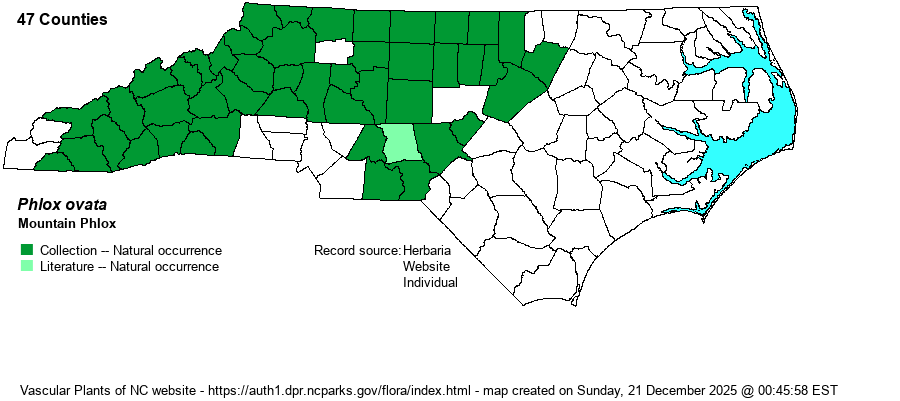| Author | L. | |
| Distribution | Throughout the Mountains, and present over nearly all of the Piedmont, but scarce to locally absent in the southern Piedmont (near the SC border) and perhaps in the far northeastern corner. Not present in the Coastal Plain.
This is mostly a central and southern Appalachian species, ranging mainly from PA southwest to central AL; there is a disjunct population in OH and IN. | |
| Abundance | Fairly common to frequent in the Mountains; infrequent in the Piedmont, though widespread; not as numerous or common in the state as the range map might suggest, at least in the Piedmont. | |
| Habitat | This is a more forest-based species than most others, often found in full shade of medium-growth mesic to fairly rich upland forests. However, it is not really a species of Rich Cove Forests or Basic Mesic Forests, but more in Mesic Mixed Hardwood Forests and various oak forests. It also grows along mesic wooded borders and in openings in upland woods. | |
| Phenology | Blooms in May and June, and fruits mostly in July. | |
| Identification | This is an erect, or decumbent at the base and then becoming erect, herb ranging to only about 1-1.5 feet tall. It has only about 3-4 nodes below the inflorescence, with the opposite leaves being mainly ovate to lanceolate, about 3 inches long and 1-inch wide. The flower cluster at the top of the stem is moderately rounded and a few inches high and across. The rose-pink flowers are similar to others, being tubular with 5 flared lobes, with the flower about 1-inch across. This species should be easily identified by its combination of rose-pink flowers and only 3-4 sets of opposite leaves; P. divaricata also has very few paired leaves, but the flowers are lavender-blue and usually has narrower leaves. As with a number of other Phlox species, these are quite conspicuous when in bloom, and the group seems to have been actively collected over the decades, such that range maps are mostly well-fleshed out and making each one of them seemingly quite common on the landscape, when in fact they are not truly common. | |
| Taxonomic Comments | The species has been called as P. latifolia in some references.
| |
| Other Common Name(s) | Appalachian Phlox, Allegheny Phlox, Wideflower Phlox | |
| State Rank | S4 | |
| Global Rank | G4 | |
| State Status | | |
| US Status | | |
| USACE-agcp | | |
| USACE-emp | | |

